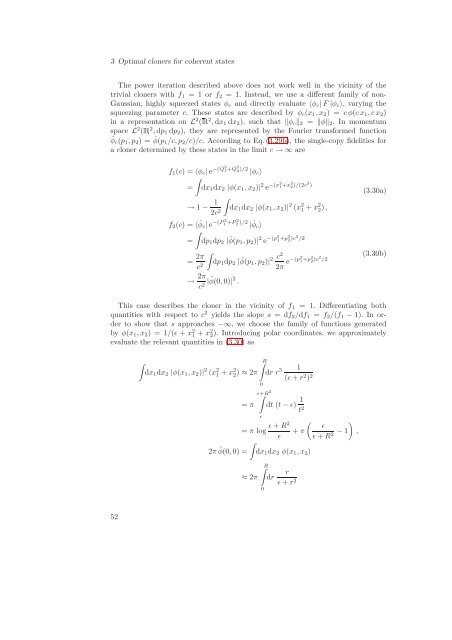Quantum Information Theory with Gaussian Systems
Quantum Information Theory with Gaussian Systems
Quantum Information Theory with Gaussian Systems
You also want an ePaper? Increase the reach of your titles
YUMPU automatically turns print PDFs into web optimized ePapers that Google loves.
3 Optimal cloners for coherent states<br />
The power iteration described above does not work well in the vicinity of the<br />
trivial cloners <strong>with</strong> f1 = 1 or f2 = 1. Instead, we use a different family of non-<br />
<strong>Gaussian</strong>, highly squeezed states φc and directly evaluate 〈φc| F |φc〉, varying the<br />
squeezing parameter c. These states are described by φc(x1, x2) = c φ(c x1, c x2)<br />
in a representation on L 2 (Ê2 , dx1 dx2), such that φc2 = φ2. In momentum<br />
space L 2 (Ê2 , dp1 dp2), they are represented by the Fourier transformed function<br />
ˆφc(p1, p2) = ˆ φ(p1/c, p2/c)/c. According to Eq.(3.29b), the single-copy fidelities for<br />
a cloner determined by these states in the limit c → ∞ are<br />
f1(c) = 〈φc| e −(Q2<br />
1 +Q2<br />
2 )/2 |φc〉<br />
<br />
=<br />
dx1dx2 |φ(x1, x2)| 2 e −(x2<br />
1 +x2<br />
2 )/(2c2 )<br />
→ 1 − 1<br />
2c 2<br />
f2(c) = 〈 ˆ φc| e −(P2 1 +P2 2 )/2 | ˆ φc〉<br />
<br />
=<br />
= 2π<br />
c 2<br />
<br />
dx1dx2 |φ(x1, x2)| 2 (x 2 1 + x2 2 ),<br />
dp1dp2 | ˆ φ(p1, p2)| 2 e −(p2 1 +p2 2 )c2 /2<br />
<br />
dp1dp2 | ˆ 2 c2<br />
φ(p1, p2)|<br />
2π e−(p2 1 +p2 2 )c2 /2<br />
→ 2π<br />
c 2 |ˆ φ(0, 0)| 2 .<br />
(3.30a)<br />
(3.30b)<br />
This case describes the cloner in the vicinity of f1 = 1. Differentiating both<br />
quantities <strong>with</strong> respect to c2 yields the slope s = df2/df1 = f2/(f1 − 1). In order<br />
to show that s approaches −∞, we choose the family of functions generated<br />
by φ(x1, x2) = 1/(ǫ + x2 1 + x22 ). Introducing polar coordinates, we approximately<br />
evaluate the relevant quantities in (3.30) as<br />
52<br />
<br />
dx1dx2 |φ(x1, x2)| 2 (x 2 1 + x2 2<br />
R<br />
) ≈ 2π dr r 3<br />
0<br />
1<br />
(ǫ + r 2 ) 2<br />
ǫ+R<br />
= π<br />
2<br />
<br />
dt (t − ǫ)<br />
ǫ<br />
1<br />
t2 <br />
ǫ + R2 ǫ<br />
= π log + π − 1<br />
ǫ ǫ + R2 2π ˆ <br />
φ(0, 0) = dx1dx2 φ(x1, x2)<br />
R<br />
≈ 2π dr<br />
0<br />
r<br />
ǫ + r 2<br />
,
















